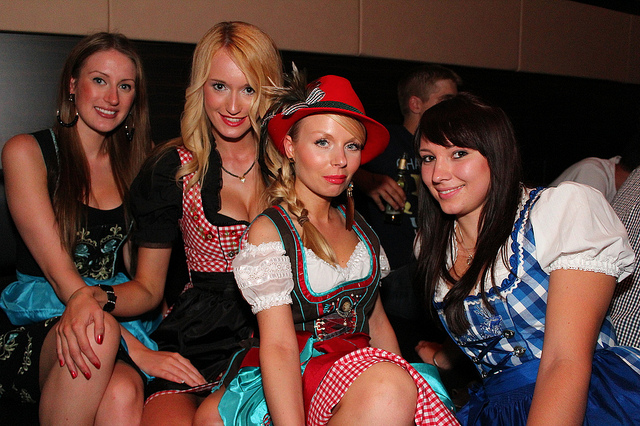
Nowadays, dirndl is worn by the German women in the cultural programs and events. Photo by avarty
This country, who leads science and technology, owes a magnificent history and having one of the ideal places in the world to live, is the largest populous country of the European Union. It is located in the central Europe, the territory of which was first inhabited by Celts and then it became the land of the Germanic tribes. Today, it is known as the Federal Republic of Germany which has the area equal to Montana, US. The current German state was founded in 1949 after the end of the World War II.
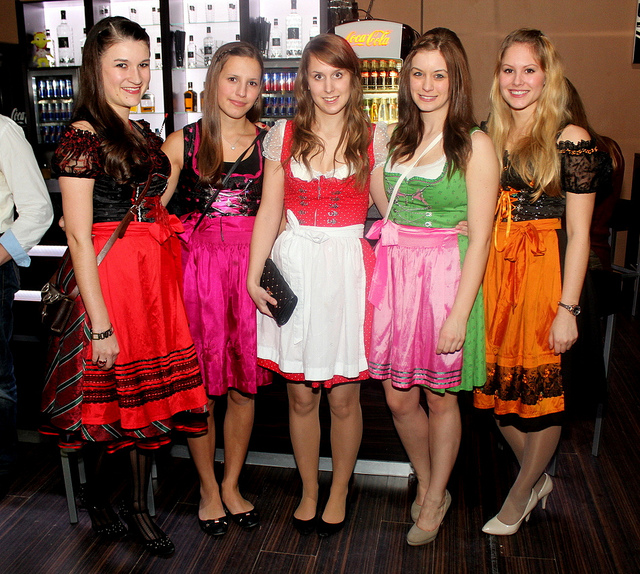
Germany is a fascinating land of literature, art and culture. There are hundreds of theaters and professional orchestras in the country and it has wonderful big cinema industry. The history of Germany is written on its walls and architecture. Obviously, in addition to the features of striking heritage of this land of thinkers and poets, Germany has also fantastic clothing culture and traditions. Germany is one of the leading countries in the fashion world and German fashion is popular all around the lovely planet in the ready-to-wear and custom-made creations.

Traditional dress of Germany is a well preserved item in the German cultural heritage which is fabulously exposed in the cultural festivals and traditional events held in the country. Millions of Germans participate in such events with pride and patriotism and make their appearance bright and colorful by wearing the traditional German costumes. Drindl, tracht, lederhosen, loden cape, gamsbart and many other outfit items are symbolic not only in the culture of Germany but also in all other German speaking nations, particularly Austria.
See also – Traditional dress of Austria: Dirndl, Lederhosen and Tracht

Altdeutsche Tracht, can be understood as the basic current in the German fashion clothing as the same was also once considered as the national dress of Germany. It was introduced in Germany in the start of the nineteenth century during the time of what is in German historiography known as the Befreiungskriege, the “liberation wars”, the last years of the Napoleonic Wars. The popularity of this clothing fashion affected every walk of life as they accepted it as a symbol to reject the foreigner’s domination upon themselves. Prominent features of this traditional fashion of Germany included the puffed and slashed sleeve, wide open collars, tight fittings long cut skirts, matching footwear along with large velvet berets. The dress played a vital role in the resistance movements in the country as it was an attempt to establish itself as an icon of national identity or identical emblem of Germanic peoples.

Leather is historically one of the materials commonly used for clothing. From the alpine areas of Germany and other surrounding countries, a popular traditional male dress is lederhosen which was basically known as the attire of the working class. Lederhosen were once widespread among men of the Alpine and surrounding regions, including Bavaria and Austria. Lederhosen have remained regionally popular and are commonly associated with virility and brawn. Typically, lederhosen are the leather shorts and usually those are having simpler cutting for the young boys. Men’s Lederhosen are more heavily ornamented, and the straps of the suspenders used to secure the shorts may also have embroidery and other ornaments. Different regions have different traditional decorations.
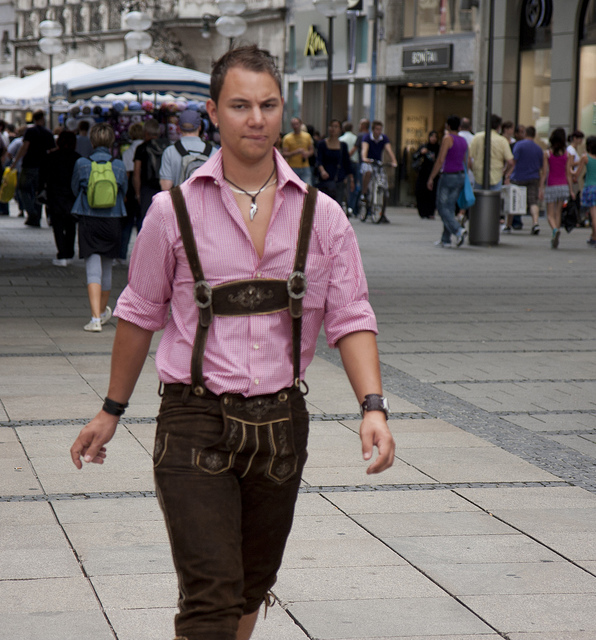
German boys used to wear lederhosen up to the age of about sixteen years. These lederhosens were not decorated with embroidery but had the typical attributes of suspenders/braces and drop-front flap.

The dirndl is the traditional dress especially for the women of Germany especially in the state of Bavaria which is used as an everyday dress primarily by older women in rural areas. Other women may wear it at formal occasions and during certain traditional events. Nowadays, dirndl is worn by the German women in the cultural programs and events like the most popular, the Oktoberfest. This superb event which takes place every year has grabbed the attention of the worldwide visitors who are coming to attend this tremendous event since last two centuries.
See also : Oktoberfest of Germany

A dirndl skirt generally describes a light circular cut dress, gathered at the waist that falls below the knee. It is basically a ruffled apron dress worn by German women that consists of a bodice, or blouse, and a skirt. The winter style dirndl has heavy, warm skirts and aprons made of thick cotton, linen, velvet or wool, and long sleeves. The colors are usually rich and dark. The summer style is lighter and more frivolous, has short sleeves, and is often made of lightweight cotton.

Accessories may include a long apron tied round the waist, a waistcoat or a wool shawl. As far as jewelry is concerned, women often sport necklaces, earrings and brooches made of silver, the antlers of deer or even animals’ teeth. For colder weather there are heavy dirndl coats in the same cut as the dresses, with a high neck and front buttons, thick mittens and wool hats. Along with the dirndl, German women prefer to wear traditionally a soft, felt shoe with clunky heels and decorative ideal for free movements and stepping during dance.

A typical fur coat of the Tyrolean origin was introduced by the peasants which is known as Lodencape. Traditionally it is made with thick and water resistant woolen material. The fabric is derived from the course, oily wool of mountain sheep and has a traditional bluish-green color. Today it is worn with modern variations in Germany and Austria.

Tracht is a pure traditional costume in Germany. These dresses were sewn with lots of skills by expert tailors who prepare them with fine linen and felt fabrics. Wool and silk were the other materials that were used in making more expensive trachts. Hand stitched embroidery was the additional beauty of this elegant dress that adorn it in spectacular style. Today, these traditional outfits are prepared with more artistic delicacy and adorable decorations for the tourists coming to Germany. The traditional Trachten vests and waistcoats are favorite among Germans during their folklore ceremonies and national events.
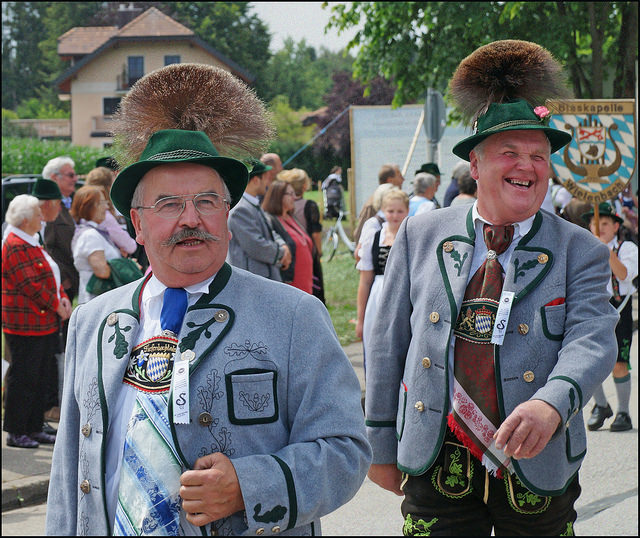
The Gamsbart is a tuft of hair traditionally worn as a decoration on trachten-hats in the alpine regions of Germany. A Gamsbart is usually constructed by enclosing the lower end of the tuft of hair in a setting of metal or horn that allows the upper end to spread in a brush-like fashion. Traditionally, hairs are selected for a dark color at the lower end with a very light tip. The size and diameter of the Gamsbart are important signs of the wearer’s pride and manliness.
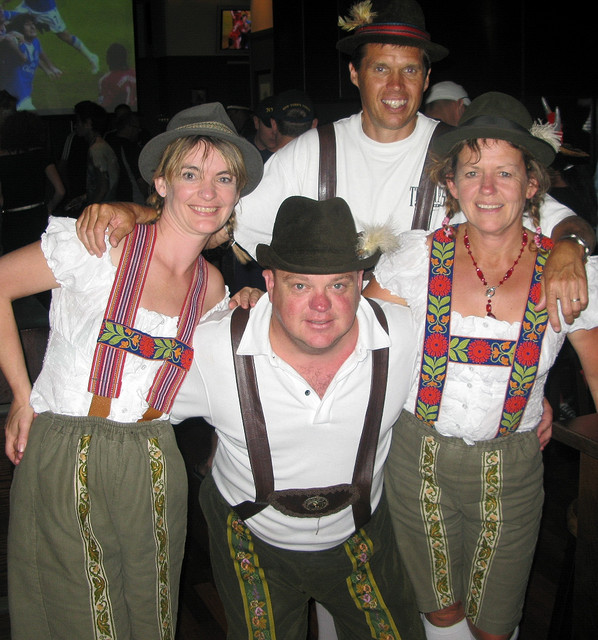
The Tyrolean hat or Alpine hat is a type of headwear that was originally a crown tapering to a point and was made of green felt with a brim roughly the width of a hand, something that was especially common in the Zillertal. There are various forms of Tyrolean hat. Frequently the hats are decorated with a colored, corded hatband and a spray of flowers, feathers or “brush” at the side of the crown. The traditional “brush” is made of the tail of the chamois goat. It takes a variety of forms, and may often be combined with feathers. Tyrolean hat has become the image bearer of “Tyrolean culture” as a tourist symbol, influenced also by folk music bands who wore fanciful “local” costumes.

Although, Germany is considered as a fashion hub presently which is having one of the largest textile industries in the world; traditional dress of Germany keeps its prevalence in the museums, books, history, folklore and performances during the native festivities. The German youth truly consider and regard it as the identical emblem of Germanic peoples, even in the current era of fashionable swinging. Even today, they owe it and accept it as a matter of pride and national loyalty.
For more interesting posts with the same subject on the Lovely Planet Website, please click the following links;
1- Algerian Traditional Dress 2- Traditional Dress Of Serbia 3- Traditional Dress Of Kosovo 4- Traditional Dress Of Libya 5- Traditional Dress Of Morocco 6- Traditional Dress Of Albania 7- Traditional Dress Of Tunisia 8- Traditional Dress Of Lebanon 9- Traditional Dress Of Bosnia And Herzegovina 10- Traditional Dress Of Azerbaijan 11- Traditional Dress Of Turkmenistan 12- Traditional Dress Of Kazakhstan 13- Traditional Dress Of Kyrgyzstan 14- Traditional Dress Of Uzbekistan 15- Traditional Dress Of Tajikistan 16- The Traditional Dress Of Laos 17- The Traditional Dress Of Vietnam 18- Traditional Dresses Of The World – 1 19- Traditional Dress Of Jammu & Kashmir 20- Ottoman Dresses From Turkey 21- Colors Of Cholistan 22- Cultural Dresses Of Balochistan 23- Lehenga Choli Or Ghagra Choli 24- Sari Or Saree : Traditional Dress Of Women In South Asia 25- Ajrak , The Traditional Attire From Sindh , Pakistan 26- The Traditional Tais Of East Timor 27- Shalwar Kameez: The Popular Dress Of South Asia 28- Churidar Pajama: The Favorite South Asian Attire 29- Pakistani Bridal Dress 30- Rilli, Sindhi Quilt Art 31- Fantastic, Alluring Khussa Shoes 32- Customs And Traditions Of Kalash Tribe 33- Hanfu, The Classical Chinese Dress 34- London Fashion Week 35- Fashion Week Milan: The Glamorous Event Of Italy 36- New York Fashion Week 37- Paris Fashion Week 38- Traditional Dress Of Jordan 39- Traditional Dress Of Syria 40- Traditional Dress Of Afghanistan 41- Traditional Dress Of Palestine 42- Traditional Dress Of Oman 43-Traditional Dress Of Nigeria 44- Traditional Dress Of Hungary 45-Traditional Dress Of Ukraine 46- Malaysian Traditional Dress 47- Traditional Dress Of Kenya 48- Traditional Eastern Brides 49- Traditional Dress Of Bulgaria 50- Traditional dress of Uganda 51- Traditional Dress of Iceland 52- Traditional Dress of Croatia 53- traditional dress of Norway 54- Traditional dress of Finland 55- Traditional Dress of Philippines 56- Traditional dress of Denmark 57- Traditional dress of Belarus 58- Traditional Dress of Puerto Rico 59- Traditional Dress of Nicaragua: Marvelous and colorful 60 – Traditional Dress of Nepal: Whimsical but charming 61- Brilliant Colors of Dagestan: Really fanciful and imaginative 62- Kabuki: A classical and traditional Japanese theater 63- Boogie-woogie: A famous Swing Dance 64- Colors of Samba Dance from Brazil: So lively so amazing 65- Ho Jamalo: The favorite folk dance of Sindh 66- Odissi from the Eastern India: A historic ritual dance 67- Sattriya from Assam: A classical Indian dance 68- Fandango: A famous couple dance from Spain 69- Maypole from Europe: A fabulous circle folk dance 70- Cueca: The national dance of Chile 71- Traditional dress of Belgium: A charming European attire 72- Traditional dress of the Kingdom of Saudi Arabia 73- Colors of Kalash: 5 lovely images of beautiful Kalash girls 74- Traditional dress of Georgia: The fantastic Chokha 75- Traditional dress of Argentina: The warrior Gaucho costume 76- Traditional dress of Venezuela: Not complicated but decorated 77- Traditional dress of Latvia: Made with the Linen fabric 78- Traditional dress of Romania: So captivating and graceful 79- Traditional dress of Estonia: So classy and versatile 80- Traditional dress of Armenia: So colorful and diversified 81- Traditional dress of Angola: A symbol of the ethnic culture 82- Traditional dress of Austria: Dirndl, Lederhosen and Tracht 83-Traditional dress of Namibia: Far from the modernizations 84- Traditional dress of Zambia: Rare but unique in nature 85- Traditional dress of Slovakia: Kroje , decorated and cultural 86. Traditional dress of Qatar: Pure Arabian endowment 87. Traditional dress of Brazil: So bright and colorful in nature 88. Traditional dress of Colombia: So iconic in Latin America 89. Traditional dress of Chile: So artistic and cultural 90. Traditional dress of Mexico: Blend of indigenous and imported cultures 91- Traditional dress of Panama: The exotic Mola and La Pollera 92- Traditional dress of Cuba: A product of multi-cultural effects 93- Traditional dress of Bangladesh: So awesome in its nature and kind 94- Traditional dress of Indonesia: Featured with unique patterns and designs 95- Traditional dress of Pakistan: Legacy of ancient civilizations 96- Traditional dress of Russia: A symbol of ethnic diversity in the Russian Federation 97- Traditional dress of England: Outcome of the local and European clothing repercussions 98- Traditional dress of Mauritania: Fusion of Berber and African cultures 99- Traditional dress of Egypt: Legacy of ancient Kings and Queens 100- Traditional dress of Iran: A product of the glorious Persian heritage 101- Traditional dress of Iraq & Kurdistan: Offshoot of the ancient acculturation 102- Traditional dress of Costa Rica: A charming garb of Latin America 103- Traditional dress of Italy: A garnished garment with beauty and style 104- Traditional dress of Antigua and Barbuda 105- Traditional dress of Eritrea: Proudly worn by Eritreans 106- Traditional dress of Ethiopia: Colors of Ethiopian culture 107- Traditional dress of France: Found in many versions 108- Traditional dress of Spain: Colors and history of Spanish culture
Dear Sir/Madam,
Our Company AHSAN LEATHER WEARS Established in 1996. We have a great experience to Manufacturing & Supplying all sorts of leather Garments & other Bike Accessoris.We are Supplying our Products toU.K, U.S.A & European Market. We Manufacture Special Quailty for Special Riders.
We always give full attention to improve our quality of products and try to our best to make satisfy all new & old customer.
RANGE OF OUR PRODUCTS:-
Leather Motor Bike Jackets, Leather Motor Bike Trousers, Leather Motor Bike one piece Suits, Leather Motor Bike Tow Pice Suits, Leather Motor Bike Gloves, Leather Chaps & Vest, saddle Bags, Toll Rolls, Leather Ladies Wears, Fashion Garments, Protection, Leather Coats, Accessories and all sort of Gloves. Kids Leather Jackets/ Jeans/ Suits
Vest and Kids Leather Gloves also Available.
Ahsan Leather Wears®
Address Green Town Bograh, Haji Pura,
Daska Road,51310 Sialkot-Pakistan.
CEL 92 346 6480254
FAX 92 302 6683087
TPHON 052-3253238
EMAIL [email protected]
EMAIL [email protected]
EMAIL [email protected]
WEBSITE http://www.Ahsanwears.com